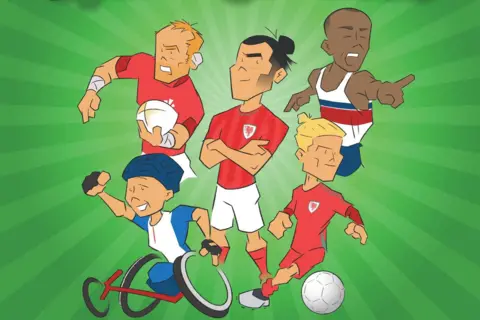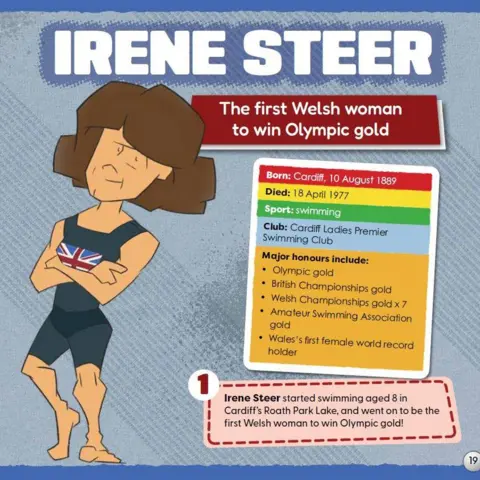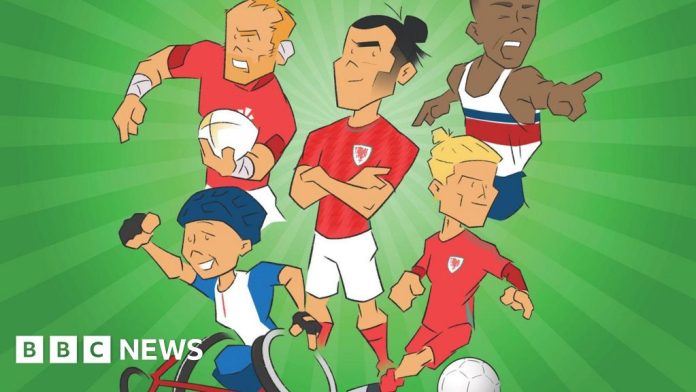 James Stafford / Telor Gwyn/ Y Lolfa
James Stafford / Telor Gwyn/ Y LolfaThe careers of Welsh sporting heroes such as Jess Fishlock, Alun Wyn Jones and Gareth Bale are being used to help children with dyslexia to read.
Because of Covid, pressure on parents and distractions such as electronic devices, author James Stafford was concerned less youngsters were reading, so wanted to bring the stars of Welsh sport to life to encourage them.
His book Wonderful Welsh Sporting Heroes, and Welsh language version Arwyr Chwaraeon Cymru, does that with colourful illustrations, interesting facts and career highlights.
Some of the lesser-known people documented include Irene Steer – who started swimming in Cardiff’s Roath Park Lake when she was eight, and became Wales’ first female Olympic gold medal winner.
“I had two big reasons for wanting to write this – firstly, I think in Wales we aren’t always the best at recognising the achievements of our own sporting people,” James said.
“Secondly, and more importantly, I worry lots of children aren’t reading enough and I think that sport can be a great gateway to literacy for many kids who may otherwise be reluctant to pick up a book.”
Those featured also include Paralympian Dame Tanni Grey-Thompson and hurdler Colin Jackson.
It tackles issues such as racism and disability exclusion, but talks about them in a way seven to 11-year-olds can understand.
 James Stafford / Telor Gwyn/ Y Lolfa
James Stafford / Telor Gwyn/ Y LolfaFrom visiting schools, James realised that children had a lot of things competing for their attention.
“Not only is sport something lots of children love, but it can also be something adults and children can bond over,” he added.
“So I thought that an accessible illustrated book about Welsh sporting heroes would be something kids, parents, grandparents and teachers might all enjoy reading together.”
His editor at publisher Y Lolfa, Carolyn Hodges, developed schoolbooks at Oxford University Press, and she added: “We were careful in our design choices for the book, trying to maximise visual appeal whilst following British Dyslexic Association guidelines as much as possible.”
What is dyslexia?
Dyslexia is a learning difficulty that affects about one in 10 people in the UK, including adults as well as children.
If somebody has dyslexia, they might have difficulties with their reading, writing or spelling.
It does not affect intelligence and is not a disease or illness – it is a condition that someone is born with.
People with dyslexia often describe the effect of text “jumping around”, so shorter chunks are easier to keep your place in.
Adaptations to make text easier to read meant attention was paid to fonts, background colours, and how it was aligned to make it easier for the eye to move over it.
Other things included avoiding block capitals in headlines, keeping sentences short and concise, and numbering paragraphs so it is instantly clear what order to read them in.
 James Stafford / Telor Gwyn/ Y Lolfa
James Stafford / Telor Gwyn/ Y LolfaJames added: “It may surprise people that creating a children’s book like this is in many ways even harder than writing for adults.
“You still must carry out enormous amounts of research, but you ultimately have much less space to tell your story.”
It contains inspirational life stories, fascinating facts, trivia, stats, a bit of social history and is all topped off with bold illustrations by Telor Gwyn.
“Two of my favourite biographies in the book are Tanni Grey-Thompson and Chris Hallam who both played a huge part in changing perceptions about disability sport and have inspired millions of people,” he added.
“However, it’s also important to describe how, not very long ago, athletes like Chris and Tanni were often treated appallingly, got very little funding and faced all sorts of obstacles and setbacks.”








